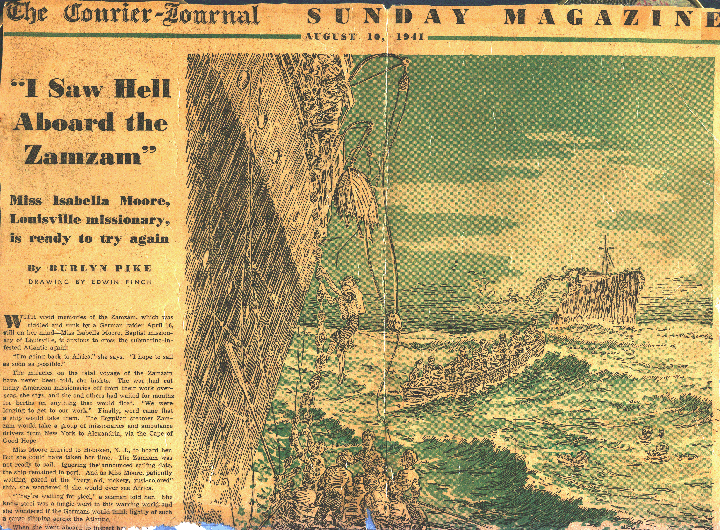
Up on the fourth floor of this building, thousands of
boxes, films, audio tapes sit quietly on shelves. These are the Billy
Graham Center Archives. There are multitudes upon multitudes of documents,
images, recordings resting here, all telling some small part of the story
of Christian witness. Every year we take some of these documents to tell
you a story on Alumni weekend. In the past we have told conversion tales
or remembered the dramatic events of a single year or highlighted one
life.
|
This year I would like to tell you about a journey that
never ended, aboard a vessel named Zamzam, which means
“Stop, Stop” in Arabic.
|
The ship called the Zamzam was a British
luxury line turned troopship turned carrier of pilgrims to Mecca turned
freighter and passenger ship turned a budding international incident turned
finally into a symbol of a violent April morning as well as the unpredictability
of human existence and the consistency of God’s care. |
From one perspective, the Zamzam story is a small
incident, almost insignificant, looked at either from general world history
or the history of missions. But, as with every human story, when you examine
it you find an almost infinite depth and complexity that reflects not
just our world and human nature, but the interaction between physical
and spiritual and the mystery of God’s working in our lives.
|
In my brief time, I can only hope to give you a summary and inadequate introduction to this story and tell you a very few of the stories of the Zamzam. |
This talk is drawn from interviews, newspaper clippings,
court records, photos and many other documents. in the Billy Graham center Archives. Besides the documents that can be found in various collection, we have one collection, Collection 624, which contains only materials about the Zamzam incident. The guide for this collection can be found at: http://www2.wheaton.edu/bgc/archives/GUIDES/624.htm
|
| But he might just as well been referring to the continuing
impact of that sinking on the hundreds of people on that ship and their
children and their children’s children. The Zamzam sunk in
a few hours, the lawsuit lasted a couple or years, but the consequences
of the sinking have proved even more long-lasting than a lawsuit, continuing
as they have until this day. |
| The story starts in the year of our Lord 1941. The Allies,
led by Great Britain, are battling the Axis, led by Germany. American is
neutral. A titanic political battle is being waged. On one side are who
believe the United States should support the Allies, even join the war on
their side, because Hitler’s Germany is a threat to American security
and represents great evil. On the other side are those who say the United
States should stay out of the war, whether because the the country’s
interests are not involved or because of suspicious of Great Britain or
sympathy for Germany. The Axis-Allied war is being waged by their navies
on all the world’s ocean, especially the Atlantic. |
| For missionaries, this means that, besides being very dangerous to travel
to and from Africa, it is almost impossible to find a ship that will take
them. But in 1940 and 1941, a number of mission agencies heard about a possible
means of travel. |
|
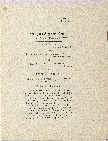 |
According to accounts of the plaintiff in court documents
from 1947, the Thomas Cook & Sons travel agency and the Alexandra
Navigation Company told mission agencies that, “there would be little
or no risk whatever in sailing on the Zam Zam. The plaintiff was assured
that the vessel would fly the flag of a neutral country, Egypt; that she
would conduct herself on the voyage in a neutral manner and avoid combat
zones. For the children, plaintiff was further informed that the Zam Zam
"will probably be a 'Paradise' as each will have some twenty-seven
other playmates on board!'” |
| So successful had the sales ploy been that when the Zamzam pulled
away Jersey City harbor on the evening of March 20, 144 of the 202 people
onboard were missionaries and missionary families. |
|
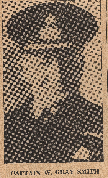 |
The crew of the ship was not as enthusiastic as their employers about
having missionaries as passengers. Charles Murphy, one of the non-missionary
passengers, later wrote in Life magazine that shortly after the ship pulled
into Baltimore for a one day stop, “Captain William Gray Smith looked
down unhappily on the pier where 120 missionaries sang Lead Kindly Light,
and two dozen cheerful irreverent ambulance drivers tried to drown them
out with an impudent song of their own. Smith, a bouncy little Scot with
a weather-reddened face, turned to his chief engineer. “Mark my words,
Chief,” he said grimly. “It’s bad luck for a ship to have
so many Bible punchers and sky pilots aboard. No good will come out of this.” |
| The Zamzam had started life in 1909 at the British
ocean liner Leicestershire. Its four masts gave it a distinctive profile.
During World War I, she was requisitioned by the British government to carry
troops. This fact was to have destructive results later. |
|
| After the war, the ship went through various owners until by the 1930s
it had been renamed the Zamzam, an appropriate symbolic title,
since one of its purposes now was to carry Islamic pilgrims back and forth
to Mecca, where the Zamzam well is located. |
|
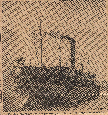 |
In 1940, the Egyptian shipping company owning the Zamzam began the ship on the potentially lucrative route between Africa and North America. Its first voyage began in December when it sailed from Alexandria Egypt via the Red Sea to Capetown and Jersey City, New Jersey and Boston on a sixty day voyage. The return leg was to start at Hoboken, and travel on to Baltimore, Trinidad, Brazil, Capetown and various cities of the east coast of the African continent before arriving in Alexandria again. |
| The captain and chief engineer were Scotsmen , the passenger stewards were mainly Greek | |
 |
and the crew Egyptian and Sudanese. |
| Aboard the ship, as mentioned were 144 missionaries and their families, representing various Lutheran, Baptist, Methodist, and Presbyterian missions as well as the | |
| Missionary Oblate order of the Roman Catholic Church, the Assemblies of
God, the Brethren in Christ, Disciples of Christ, the Progressive Brethren,
Seventh Day Adventists and independent missions such as Africa Inland Mission,
Congo Inland Mission, the Scandinavian Alliance, the Sudan Interior Mission,
and the World Wide Evangelization Crusade. |
|
| Click here to see the passenger list as it appeared in the New York Times on May 20, 1941 | Among the non missionary passengers were |
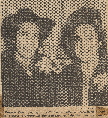 |
nurses from Greece, |
 |
twenty-four volunteers of the British-American Ambulance Corp going to
North Africa to serve as non-combatant drivers, a small group of tobacco
buyers from North Carolina traveling to Salisbury, Rhodesia, the
head of the government survey for India, and a New Jersey mattress manufacturer. |
| One of the missionaries, Walter John Guilding, wrote to his board, Africa
Inland Mission, “And when he putteth forth his own sheep, he goeth
before them." As we depart for Africa, the above words come very vividly
to our minds. May we realize in a deeper measure the truth of them. We are
conscious of the fact there may be dangers ahead as we cross the seas and
varied experiences to pass through, but we can rejoice in that our heavenly
Father knows, cares and is going before us and believe will take us to the
very places he has purposed and planned for us.” |
|
 |
On March 13, missionaries George and Marguerite Belknap were waiting to
board the ship. |
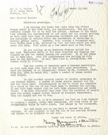 |
They wrote, “We are sailing on an Egyptian Steamer called the 'Zam
Zam.' Yesterday while at the pier checking and tagging our luggage we saw
the vessel taking our supplies. It is not large but very nice.” After
a little time spent on board, most passengers were ready to agree with the
first description, but not the second. The ship was old and space was at
a premium, especially some of the ambulances being transported had been
lashed to the deck because of limited cargo space. |
 |
Missionary doctor Arthur Barnett remembered what was a honeymoon cabin for him and his new bride, Margaret. |
 |
“And then we were on the stern end of the boat,
and the third cargo hold came up to the top of the regular deck, sort
of an odd deck. But on each side of it, there was space there, and they
built two little cabins there, and two little cabins there, just big enough
to...long enough for a bunk to be in there, and the width wasn’t
any more...I suppose, it was maybe about 8 by 8, or something like that.
But we were...got our honeymoon cabin as one of those. So we squeezed
in it, and we thought we had a nice little cabin out right on the deck.
And there was nothing...no closet in it, no hooks in it, nothing in it.
So we got a nail that...that was up in the center between the bunks to
hang some clothes up on it.” |
| Different groups tended to keep to themselves and find different ways
to while away the voyage. One gets the impression the passengers divided
up into little groups and relations between them was not all too friendly.
The captain, for example, is later supposed to have complained that he,
“had quite a few headaches as regards his passengers who...had been
separated into three feuding groups—the American missionaries who
wanted the bar shut; the American ambulance men who wanted it open; and
the British who presumably wouldn’t have minded so long as it closed
at 10.30 in the evening.” |
|
| Journalist Charles Murphy confirmed this view of the voyage, “On
ships, even more than on land, people tend to band themselves into little
jealous cliques. The conglomeration on the Zamzam carried this tendency
to the point of grotesqueness. The ambulance drivers, mostly young men in
their early 20’s, made one self-sufficient group. The little bar aft
became their stronghold, just as the saloon forward, where only tea or coffee
and cookies were served, became the bastion of the missionaries.” |
|
 |
William Wydenbruck-Loe, a former Austrian count who had become an American
citizen and who was sailing to Kenya to drive an ambulance for the Free
French, wrote in a letter mailed before the ship left Brazil, that the missionaries,
“spent several hours a day singing hymns, accompanied by a trombone
player.” He also mentioned that some missionaries held classes in
the Swahili language, which some of the ambulance drivers attended. |
 |
Another passenger, Isabel Russell Guernsey, wrote later, “There
we were, a motley throng, all with different high hopes, I suppose: the
missionaries of saving souls, the ambulance boys of saving bodies, the
tobacco men of enlarging their scope of business; and we freelancers of
picking up the threads of a normal existence interrupted by war and other
things.” |
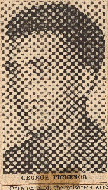 |
Ambulance drivers, George A. Tichenor, wrote home, “One of [the
missionaries] tried to convert me, but I told him I was as happy as he was,
and that hell was just another worry and that stopped him.” |
| Click here to see a longer version of the poem | A tobacco buyer from North Carolina described some of the discomforts
and tensions of the voyage in a humorous poem, from which I quote a few
excerpts: |
| Some of the passengers were alarmed when after leaving Trinidad, the crew
blacked out the ship portholes and sailed without lights at night. Egypt,
technically was a neutral. Therefore the ship was a neutral and in theory
should not be attacked by the German surface raiders and submarines. However,
some passengers would the precautions taken invite attack. The Zamzam,
however, had sailed blacked out from Alexandria and the Captain, William
Smith, following the instructions he received from the British admiralty,
continued to do so on the return trip. |
|
| At the last Western Hemisphere stop in Recife, Brazil, editor Charles
Murphy of Fortune Magazine and photography David Scherman of Life magazine
boarded. They were traveling to South Africa to do a story on the war effort
there. Murphy later recalled, “Scherman and I boarded the Zamzam at
Recife, having flown to Brazil to save time at sea. The Zamzam, due April
1, arrived a week late. When we hurried down to the docks to confirm the
miracle of her appearance, the rails were crowded with people clamoring
to be let off. Some were shouting rude jibes at the dock workers. A passenger
bellowed down at us: “If you two intend to come aboard this wreck,
don’t ever say we didn’t warn you what you’re in for.
The food’s lousy, the crew’s lousier.” He pointed toward
the stack, where the word MISR, from the company’s name, was visible.
“They even call her the Misery Ship.” The Zamzam put out for
Capetown April 9, delayed for two hours by one of the table stewards, who
had overslept in a brothel.” |
|
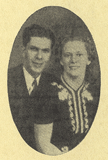 |
Many passengers indicated at the time and later that they were enjoying
the cruise through the warm south Atlantic. There was another newlywed missionary
couple aboard. Fred and Doris Young were heading for their first assignment
as well. Doris recalled an evening in mid April: |
 |
“We were in the cabin of our friends and we were playing the game Battleship. And we laugh about it now, but it wasn’t really so funny. It turned out that Fred and my battleship was su...was sunk in the game. As we were walking back to our cabin along the moonlit deck, Fred noticed and said how, “My, look how...what a peaceful scene. It is hard to realize there is a war anywhere on this earth when it is so peaceful. The moon was shining on the water. It was just beautiful.” |
| Click here to see the text of the three letters that W. J. Guilding wrote from the Zamzam | On April 5th, John Guilding sent a letter to the Africa Inland Mission
office in New York in which he described the traditional crossing the
equator ceremonies: “On Saturday we crossed the Equator + there
certainly was some doings. There is no swimming pool on board so the hose
was used. A few of our party went through the ordeal. It caused some fun,
but was taken to the extreme + one fellow was hurt. Our daily prayer meeting
continue + I believe with added interest. The room is crowded. Sorry to
say some missionaries do not attend; apparently not keen on prayer. A
few I fear are worldly (perhaps 3 or 4) but the great body are just fine
Christians + we have grand fellowship together.” |
| That letter was written on April 7, mailed from Brazil and received by
the mission on April 17. By the time it was opened, the Zamzam
was sinking. |
|
 |
At approximately 5:40am on April 17, when the ship was at 27 degrees 41
minutes south and 8 degrees, 8 minutes west, most of the passengers were
asleep. It was extremely warm in the cabins. Wydenbruck-Loe had written
in a letter a few days earlier that the rooms were hot, stuffy and humid
because all the portholes had to be shut at night. |
George Tichenor said a few weeks later, “It was 5:45 in the morning
and the sun was just coming up over the horizon. I was sleeping in my
bed roll on the deck when I heard a shell whistle over my head and crash
into the water on the other side of the deck. I crawled a few feet on
my stomach when another shell landed and tore through the deck where I
had been a minute before. It was awful. I tried to get up and run to the
other side of the boat, but the shells kept coming and I would drop automatically
to the deck. Then I made my way to the lounge and as I stepped down the
stairs to the dining room, a shell crashed into the lounge and exploded.
I was too busy to be scared.” |
|
Why was it attacked? According to the memoirs of Captain Bernhard
Rogge, commander of the surface cruiser Atlantis
which was doing the attacking, “At four o’clock in the morning
we sighted a fairly large ship on a southeasterly course. She was completely
blacked out but in the brilliant moonlight was easily identified as a
merchant ship. Very soon we were able to make out four masts and I remembered
having seen some ships of the same type in Dartmouth during the Coronation
festivities before the war.” His British naval guide at the time
had told him the government used the ship to carry troops during World
War I. Based on this and the fact the ship was showing no lights and her
erratic course, Rogge decided that she was again a auxiliary cruiser for
the British navy. He wasn’t sure if she had spotted his ship or
the German supply ship Dresden and he wanted to make sure she
sent off no reports on his position. He determined to attack her at first
light, before she sent any radio messages. By the way, Rogge was a devote
Christian who himself spoke at the Sunday services he always held for
his crew. He also had a Jewish grandfather, which had required that he
get a special certificate of permission to remain a naval officer when
the Nazis came to power in Germany. |
|
| The crew of the Zamzam immediately attempted to send out an SOS
radio message, but one of the first shells to hit the ship destroyed the
radio antenna. Later, some passengers considered this a blessing, since
if the ship had managed to send out the message, the Atlantis probably
would not have remained in the area and most or all of the Zamzam
passengers and crew would have drowned. |
|
| Captain Smith tried to signal the Zamzam’s neutral status,
but the ship’s signaling lamp had been destroyed. He ordered the ship
to turn broadside to the attacker, a naval signal of submission. He then
was able to signal to the Atlantis via a flashlight and the shelling
stopped. |
|
| It had lasted about ten minutes and involved dozens of shells, nine of
which hit. The Zamzam was listing badly and its engine room was
flooding. |
|
 |
Doris Young recalled what happened after the shelling stopped:
“As we moved around the ship, we could hardly stand up,
it was at such an angle.... There was a lot of fires that some of the
crew were putting out. It was an exciting time. People were running around.
There were a few people who were hurt. Not panic, really, but disorder.
Then we saw that people getting into lifeboats.... Some of the crew members
were sliding down ropes, some of the passengers were sliding ropes which
were holding the lifeboats to the side.... We finally climbed over and
were on our way down when somebody said, “Its pulling away, its
pulling away!” And true enough, all I saw below me was water. The
lifeboat had pulled away. It was already loaded. So Fred said, “Let’s
climb back up.” Well, what else was there to do. So climb up we
did.” |
Fred Young, with the help of some other passengers, used his pen knife
to cut the ropes that held several rafts to the ship and dropped them
in the water. Some life boats were unusable because of the shelling and
worse, it was discovered when others hit the water that they were not
seaworthy and started to sink. |
|
 |
SCHELLENBERG: “And we pushed away from the boat because
we didn’t what to get caught.... |
| People in the boats quickly discovered that there was almost no provisions,
certainly not enough for a voyage to Africa or South America. The sea around
the lifeboats were filled with passengers who had been in capsized boats
or who had just jumped into the water. Some passengers later wrote that
they had completely forgotten about the German ship when suddenly they saw
it approaching. Passenger Isabel Russell Guernsey wrote, “The German
raider hove into view. In a few minutes we could see marines lining the
rails , rifles in hand pointing at those bobbing heads. Good God! They are
going to shoot them, was my first thought. Later we heard that rifles were
ready as a protective measure against possible sharks. Soon after, two motor
boats were launched and picked up the people in the water and the order
came for those of us in boats to go alongside and aboard the raider. And
that, I think, was the first moment in which I registered horror at our
situation. As my foot touched the rope ladder leading up to the Tamesis
deck, my heart did a complete flop with the thought “We are in German
hands.” The Atlantis had quickly put motorboats into the
water and picked up all the Zamzamers who were not able to swim
or row to the ship. |
|
| The Germans, along with commandeered Zamzam crew members, also boarded
the badly listing Zamzam several times and gathered up the remaining people
onboard, a good portion of the passenger’s luggage, and anything they
thought was useful. (Later passengers were allowed to sort through the luggage
that had been saved and use what of their own they could find.) |
|
One of the people still aboard was the captain, William Gray. Naval lieutenant
Ulrich Mohr later remembered, “In his hand he still carried the flashlight
with which he had eventually managed to stay our fire. Smith was one of
the very few really levelheaded people on the ship, and beside him stood
a young Egyptian cadet who had not left his side throughout the incident,
and who, in the days to come when so many of his compatriots were to occupy
themselves only with delivering petitions asking for their release as ‘neutrals,’
was to give a very fine example of seamanlike loyalty to his captain."
" |
|
At about 2pm, as the passengers watched, the time bombs placed by the
Germans on the Zamzam exploded and sunk the damaged ship. From
the time of the first shelling until the time the last of the ship went
under the water, less than nine hours had passed. But the Zamzam
would have its small measure of revenge on the Atlantis. |
|
| There were astonishingly few serious casualties. Three men were placed
in the Atlantis’ infirmary, where they received good care
in the circumstances. One of the three was Ned Laughinghouse, he of the
comic poem. He had been sleeping on deck and received serious head wounds
from shrapnel. He bravely left the Zamzam and boarded the Atlantis
on his own, but his condition steadily worsened after that. |
|
| In general, the crew of the Atlantis went out of their way to
treat the Zamzamers gently. Rogge even, when speaking to small
group of them, asked them to think of themselves as his guests. Partly,
no doubt, this was due to Rogge’s character and faith, but he had
another reason as well, which I will go into a little later. |
|
 |
Arthur Barnett remembered the first moments on board the Atlantis: “We were all put three decks down into the prison part of the raider...and the first thing we knew here was a sailor, dressed to perfection in a very white suit. In good English he said, “Can I help you with anything?” And my wife looked up and said, “Yes, you can help us. I’m barefoot. Now if you get me a pair of scissors, I can cut off the bottom of my gown and I’ll have some rags to wrap my feet up and I can help some of these other people who are skidding around in all the grease on top of the iron deck.... So they left and in the meantime while we waiting for them to come back, Peg felt...her little Bible in...in the pocket of the raincoat. So she got it out and we were just going to begin to read it then all of a sudden this gruff voice started up, “What is that you got there?!” And it was the same sailor. He had come back.... Peg said, “It’s a book. But it is more than a book. It is a Bible. It is God’s word.” So Peg turned to John 3:16 and handed it up to them like this. “Can you read that?” When he stopped, she said, “Does that say God loved the Germans?” “No.” Does it say the United States?” He said, “No.” She said, “What does it say?” He said, “God loves the world. That means you and me. You think I am a prisoner. I am not a prisoner. I know the Lord and I know where I am going. Do you know?” And he said, “You remind me of my captain.... Yes, he gets us all up on the deck every Sunday morning and speaks to us the way you are speaking to me now. He calls himself a Lutheran. Do you know what he is...what a Lutheran is?” |
| The Zamzamers were on the Atlantis for only about thirty
hours. I should perhaps mention that they had no idea they were on the Atlantis.
The German warship was going under the name Tamesis when it sung
the Zamzam. The Atlantis frequently changed its name and flag and
even had the capacity of altering its physical profile so as to create confusion
for the British naval officers trying to track its position and activities. |
|
Captain Rogge had been pleasant and courteous to the passengers, stating,
“I am sorry this had to happen.... I can only tell you that we will
do everything in our power to put you safely ashore but you must remember
that this is war and in traveling the ocean you have assumed many risks.”
He had no intention of caring hundred of civilians with him on his war
cruise. The next day all but the three seriously wounded of the Zamzamers
were transferred to the Atlantis’ supply ship, the Dresden.
Ned Laughinghouse died on the Atlantis on April 28, the only fatality
directly related to the attack. |
|
There now began for the Zamzamers a long, dreary voyage. It
had been four weeks from when they left Hoboken to the attack. They then
spent a little more than a day on the Atlantis. Now they were
to spend almost five weeks on the Dresden. |
|
There now began for the Zamzamers a long, dreary voyage. It
had been four weeks from when they left Hoboken to the attack. They then
spent a little more than a day on the Atlantis. Now they were
to spend almost five weeks on the Dresden. |
|
| Captain Jaeger, of the Dresden, barrel chested and bow legged,
had been much sterner than Rogge when he greeted his men among his new charges:
“I am Captain Jaeger, captain of this ship. If you fellows do as you
were told, then everything will be alright. But if you don’t, well,
we will take care of that too.” The captain’s irritation is
understandable. He now had more than three hundred civilians, some of them
enemy nationals added to a ship designed for perhaps a tenth that many passengers.
The male passengers outnumbered his crew. Later in the voyager, he was not
unreasonable when faced with passenger requests. Passenger Bob Mir would
write immediately after the experience that, he "was very kind and
did everything he could to make it easy for us, especially for the women
and children." Eleanor Anderson, a very young girl at the time, wrote
years later, “Although he appeared to be curt and callous, some thought
that his outward demeanor disguised a kind heart.” Most passengers
found the disguise very effective. The Dresden was not, in fact
a German naval vessel, but one of the German merchant marine contracted
by the German government to carry supplies to the German raider. |
|
The German crew was strict but not cruel and sometimes helpful. Sylvia
Oiness, a missionary nurse, wrote later in the year in a letter to the
American Journal of Nursing, "As 'involuntary guest' of
the German navy, we were not mistreated, but there was always strict and
severe disicipline." Men were separated from women and children,
and put into the cargo hatches, with the men the crew in hatch 3 and officers
and the passengers in hatch 2. Single women were assigned to the lounge
and women with children in cabins. Men were allowed up on one of the lower
decks from sunup to sunset. Women and children had somewhat more freedom
of movement. Married couples were allowed to visit together two hours
a day. |
|
 |
Roy Brill in an article written later, described these daily meetings:
“When we were finally allowed to see our wives daily, from 10am
to 12 noon became an oasis during the course of the twenty-four hours.
It was then that we compared notes, telling each other the manner in which
God had witnessed to our hearts, through His word or by His Spirit. On
one occasion, Kitty turned to me and said, Roy, I would like to give you
the verses I received from the Lord: ‘He sent from above, he took
me, he drew me out of many waters. He delivered me from my strong enemy,
and delivered from them which hated me: for they were too strong for me:
but the Lord was my stay. He brought me fourth also into a large place,
he delivered me because he delighted in me.(Psalm. 18:16-19) It is impossible
to express in words the manner in which the Lord, from time to time, comforted
our hearts with the Word.” |
| Sylvia Oiness in describing the conditions for the women wrote, "We
slept on dirty matresses on the floor with lifebelts for pillows, and one
blanket apiece as bedding. Water was rationed--two liters per person per
day. Plumbing and sanitation was atrocious. We were locked in from sunset
to sunrise, with no fresh air or ventilation." |
|
 |
Alice Landis (later Alice Schellenberg) remember some of the daily
activities: |
| Food was usually porridge and soup that mainlined life but left all hungry.
Here is how another passenger, Charles Murphy, an editor of Fortune magazine,
described it, “Our diet was almost entirely liquid. Breakfast was
“billboard paste and occasionally oatmeal with a slice of bread and
an oily tea which had little tea in it and practicably no sugar. Lunch was
what Scherman derisively christened “glop” - macaroni or rice
or bean soup with a few fragments of meat, two pieces of bread and more
tea. Supper was soup again, plus bread and tea. The women and children fared
somewhat better because they were given jam and occasionally butter.”
The food and accommodations on the Zamzam probably seemed to most of the
passengers now, as they looked back, rich beyond belief. |
|
There was a Catholic mass and daily Protestant service for the men
(a united service for men and women was held on Sundays), each about a
half hour long and school for the children. A small swimming pool (filled
with salt water) was available to the prisoners. Time was spent cleaning
the deck, doing callisthenics, making various things. |
|
| Here is the daily schedule as recorded in the diary of missionary Irl
McCallister Reveltry [sic]: 15 min. before sunrise Mass: 6:15 to 6:45 Breakfast: 7:00 Religious service: 7:42 to 8:15 Cleaning below deck: 8:30 to 9:30 Cleaning of deck: 8:30 Hospital—man: 8:30 to 9:15 Hospital—women: 9:15 to 10:00 Swimming—children: 9:30 to 10:00 Captain Rounds: 10:00 Visiting women folk: 10:00- to 12:40 Swimming single men: 10:15 to 12:00 Luncheon: 12:30 Swimming married men: 2:00 to 3:00 Swimming children and women: 3:15 to 3:45 Dinner: 4:20 Cleaning deck: 5:30 All hands below deck 15 min. after sundown |
|
| Some of the missionary-nonmisisonary tension from the Zamzam
continued. Isabel Guernsey wrote: “There was always a church service
on the fore-deck on Sundays, conducted by one or other of the missionaries.
... They were genuine people, I know, and sincere in their faiths, but one
vied with another to make those Sunday services a harrowing emotional experience–which
our shelled nerves were in no condition to take.” |
|
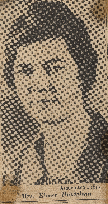 Click here for the complete poem |
There was also a poet aboard the Dresden. Lillian Danielson composed a poem after talking with some of the women about what they had lost when the Zamzam went down. Here are some excerpts:“You say you had a loss of this and that pretty gown |
| Harder on the nerves of all the Zamzamers was the continuing uncertainty.
Captain Rogge had promised that the Zamzamers would either be put onto a
neutral ship or onto the neutral coast of Brazil. Captain Jaeger had occasionally
repeated these promises or said he would land the passengers on the Canary
Islands. The passengers later believed these promises were made mainly to
keep them quiet, but Rogge, after making the initial promises, had received
orders from the German admiralty to send the prisoners to Europe, German-occupied
Europe. |
|
| Charles Murphy later wrote, “After the fiction of the neutral ship died a hard death, the real grief in hatch No. 2 began. Captain Jaeger sensed the change in mood on the foredeck and ceased his morning inspection. For the first time some of the men began to cave in under the strain. There were a number of near-fights. But as a group the missionaries stood up with admirable fortitude and good cheer.” T. O. Dosumu-Johnson, a West African who had been educated in the United States and was sailing back to Liberia with his wife and child, later wrote, "For thirty days we lived like animals, the men in the hold and the women and children midship. We were not given food or water. There was no privacy. All inhibitions disappeared." | |
| Would they be able to get to Europe? How long would it take? The Dresden
would not sail directly, of course, but would try to avoid British warships
and look for an opportunity to slip into a friendly port, an opportunity
which might take a long time to find. What if the ship was attacked by the
British? |
|
| Click here to see Robert Muir's letter about his experiences | And what would happen when they reached port? American was neutral and
the Americans had been told they would be sent home. But there were Canadians
and English missionaries as well, and many different nationalities represented
in the crew. What would happen to the crew and officers of the Zamzam who
the Germans claimed had acted in an unneutral manner? |
| Sylvia Oiness described the voyage from the South Atlantic to occupied France" " We suffered first from the terrible heat, and then from the dreadful cold. We had not enough clothes to keep warm. Colds, bronchitis, and flue developed; then dysentry because of the bad diet. Few escaped some illiness . The ship's doctor used up his small supply of medications. But among men, women, and children not one life was lost due to disease or confinemement. Witout lights, without flag, and maintiajn a vigilant watrch from the bridge, the "Dresden" pressed on. One day the crew began building a barricade around the bridge. All passengers were ordered to remain dressed day and night in case of emergency." | |
 |
Eventually the Dresden cautiously approached the coast of
France, at least once almost blundering into a British convoy, and was
able to slip through the blockade, probably because most of the British
navy in the region had been pulled off to attack the German battleship
Bismark. On May 20th a voyage (for the Zamzam passengers)
of 4,860 miles aboard the Dresden ended. She pulled into the
southern French port of St.-Jean-De-Luc, a resort town in happier days
for rich English tourists. There, Captain Jaeger of the merchant marine
watched in fury as the harbor pilot ran his ship aground on a reef in
the harbor. But it was eventually freed and the ship docked. |
Now came the great separation. All American passengers were disembarked.
Irl McCallister wrote in his diary, “. It sure was nice to step
on good solid ground after 40 days of rolling and rocking – it was
almost too good to be true. We all came to 3 hotels where we have very
nice rooms — running water, soft beds, toilets that would flush,
and most all conveniences. It surely was splendid to get into a soft bed
where sheets were on and clean and your hips did not hurt—I just
couldn’t think of all the good things to say now, but most of all
is that Flo and I were together all the time now. Most everyone was hungry
by the time we got settled because it was so late. I took a sponge bath
in cold but plenty of water before eating. About 11 P.M. (blackout time
which is 2 hours faster) we were called for dinner which was lots of butter
and brown bread and a large of hunk of salami, or a reasonable facsimile
thereof—anyway it tasted good and to see the butter piled upon your
plate and the idea of sitting at a table and everything was so grand.
We came back to room and were soon in bed with an electric light over
our bed which could be turned out with a button from our bed. " |
|
 |
I will talk about the nonAmerican prisoners in a moment. Meanwhile, the
poor decrepit little Zamzam was momentarily at the center of international
attention. The second that Rogge had seen women and children abandoning
the Zamzam, he thought of the Lusitania, the British liner that
a German submarine had sunk in World War I with dozens of American aboard,
an incident that helped bring the United States into the war. He realized,
and soon his superiors realized, this incident could bring America into
the current war against Germany. Although Captain Rogge has a high reputation
for professionalism and civility, doubtless one reason for the relatively
gentle treatment of the prisoners was the German’s high sensitivity
to the debate over neutrality in the United States and the fact that any
unnecessary brutality could be a factor in bringing America openly into
the war on the British side. |
 |
On May 18, the British Admiralty announced that the Zamzam, a neutral ship carrying with missionaries and ambulance drivers, was almost a month overdue and possibly sunk. |
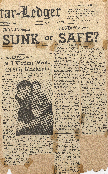 |
News stories on the 19th, especially in the United States where a no-holds-barred debate was being waged over whether the country should support the Allied side in the war. |
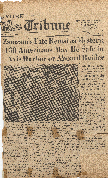 |
Everyone read about the Zamzam and the Americans held prisoners by the Germans. |
 |
Editorials and stories appeared in thousands of papers across the United States, |
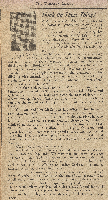 |
including the Wheaton Record, newspaper of Wheaton College. |
 |
On the 20th, the German government announced that all the passengers
had been rescued and had been safely landed in France. The Germans had
even allowed photographer David Scherman to take pictures of the sinking
of the ship and life aboard the Dresden. When the Dresden
reached France, these photos were confiscated by the German censor. But
to the astonishment of Life magazine, after the censor had reviewed them,
almost all of them were sent back to Life, which printed some of them
in the magazine at the end of 1941. The Germans, no doubt, were hoping
to score propaganda points in the United States by showing that their
treatment of the prisoners had been reasonable and even humane. |
But these were not the first pictures of the Zamzam incident
in Life, Scherman had managed to smuggle home with him in May some rolls
of film that had been hidden in reels of medical gauze, The photos showed
the attack on the Zamzam, the lifeboats on the water and the
rescue by the Atlantis, including one very good picture of the
German warship. These had been published in Life in June. By the time
the second set was published in December, the German concern for good
publicity in the United States was moot. The same issue of Life
magazine that carried the pictures also covered the Japanese Navy attack
on Pearl Harbor. On December 11, Germany declared war on the United States. |
|
 |
The Americans who had been disembarked at St. Jean on May 20th stayed for 10 days in the French town of Biarritz while the American and German diplomats negotiated their departure. Finally by June 2 they had been released from German custody and traveled to neutral Portugal where they stayed in a town near Lisbon, awaiting transportation home. Some missionaries tried to make the short trip from Spain to Africa, but it proved to be impossible because of the war. All had first to return to North America. |
 |
The first Zamzamers (David Scherman and Charles Murphy) arrived back in the United States on June 9, fifty-four days from the sinking. They had traveled via a PanAmerican Airways plane. Over the summer months, various ships sailing between Portugal and the United States brought most of the Americans back home. |
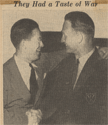 |
And for about the next six months, a blizzard of articles appeared
in denominational and national magazines, local newspapers, and other
sources telling the story of Americans who had been aboard a ship sunk
by the Nazis. |
 |
Soon, four books had been published about the survivors’ experiences. (A fifth was published in 1946.) |
 |
Many of the returned missionaries, for many months after their return,
did little more than speak to audiences about the experience. |
 |
Alice Schellenberg remembered the demand for stories Zamzam speakersSHUSTER: “Were people curious about the Zamzam? |
 |
After Pearl Harbor, though, there were other more dramatic stories in the headlines and it was no longer a novelty for Americans to have been held prisoner by the Germans. The Zamzam was quickly forgotten by the general public. Already in early 1942, one mission executive wrote to a Zamzamer who had asked about whether it would be worthwhile for her to write a book about her experiences, "...our general impression is that the great value in the story of the experience of the Zamzam experience is greatly diminished in view of the time element. The story has been told in public by so many and it has appeared in print in various publications that we question that the printing of the story at this late date would warrant the expense involved." The ballyhoo had moved on. |
| On November 22, 1941, the German raider Atlantis was sunk by
the British warship HMS Devonshire in the South Atlantic. And the photos
by Zamzam passenger David Scherman of the Atlantis published
Life magazine in June were among those used by British reconnaissance planes
to identity the Atlantis. So the Zamzam did have some
small measure of revenge. |
|
| Statistics vary, but there had been approximately 343 people aboard the
Zamzam, 202 passengers and 141 crew and officers. According to Charles Murphy’s
slightly different statistics, of the passengers, “73 were women and
35 were children. There were 138 Americans, 26 Canadians, 25 British, five
South Africans, four Belgians, one Italian, one Norwegian and two Greek
nurses. The crew numbered 129—106 Egyptians, nine Sudanese, six Greeks,
two Yugoslavs, two Turks, one Czech, one French and two British—the
captain and the chief engineer.” |
|
 |
The passengers were given this home made certificate by Captain Smith
when they disembarked, to show German officials to explain how they came
to be interned. The Germans were not concerned at all with Egyptian neutrality
and the crew was sent to an interment camp in Bulgaria, where they were
liberated by Russian army in 1944 and most apparently were repatriated to
Egypt, although American reporter Percy Knauth found some living in Yugoslavia
in 1945. The British officers were sent to internment camps for the merchant
marine in Germany. The experiences of the Egyptian crew and of the ship
officers is one of the great mysteries of the Zamzam story. Most
of the enemy nationals who were women and children, about twenty-eight,
were held a camp in the state of Wurttemburg in southern Germany some months
and then released or exchanged. The male enemy nationals among the passengers,
including the missionaries were imprisoned for much much longer, indeed
some for the entire war. |
 |
William and Lily Mundy were missionaries to Kenya. He was British and she was American, so they were separated when the Dresden reached France. |
 |
He spent over three years in Germany. On June 29, 1943 he wrote on a postcard
“I am fairly well. The weekly Bible class on Acts is attended by [on]
average 24. Letters are rare, about one a month from my wife. We have two
outings a week to sports-field. As yet I have not received a Luo New Testament.
[The Mundys worked among the Luo people of Kenya.]
Mr. Guilding is very well. He sends greetings. We rejoice in the Lord. Continue
to pray for us and the many indifferent to the Gospel. How we long to be
back in Africa in the Lord’s work, but may he use us here and fit
us for future service.” |
 |
Walter John and Clara Guilding were also Africa Inland Mission workers
in Kenya. They were both British citizens. When they disembarked from the
Zamzam in Bordeaux, they were sent to a clearing camp and separated.
A group of prisoners were sent by train to Bremervord in Germany and there
the couple were reunited for two minutes, just long enough for Clara to
tell John that she was being sent with other women to a camp in south Germany.
|
 |
Clara and the other prisoners were able to receive packages from home. This was the notification for a Bible mailed her by the American Bible Society. |
| Click here to read the letters Clara wrote to her supporters before and after her release. | She and six other Canadian women were let out of camp and allowed to live
in Berlin until arrangements could be made to exchange them for German women
held by the Allies, Clara is third from the left and right next to her is
Isabel Guernsey. By the summer of 1942, Clara was back in North America.
|
| Click here to read some of the postcards Guilding sent from his interment camp. | From 1941 to 1945 John Guilding was moved with other civilian prisoners
to four different camps in Germany and France, including one which was a
vacated lunatic asylum. A large part of each day was taken up in roll calls
and standing in line for rations, hot water and most other things. Guilding
started to teach himself Greek and also served as a chaplain in one of the
camps and his duties including sending manuscripts of sermons to the Germans
for censoring. Once the prisoners were full of hope that they would be liberated
by the approaching American army, but they moved again before that could
happen. His final camp was near Bremen in Germany. |
 |
In an article written a few weeks after his liberation he wrote, “This
proved to be the worst part of our internment, living quarters much poorer,
food worse, parades in the snow and rain, no coal a part of the time, damp
wood; we could say we really felt the pinch. That was a real test and we
who called ourselves followers of the Lord Jesus Christ had to show our
colours.... ‘Godliness with contentment is great gain’ I preached
one Sunday on Philippians 4:11.” Finally the camp itself was surrounded
by fighting German and British and shells flew over the camp. On April 27,
a little more than a week before the end of the war in Europe, John was
freed. He wrote that the verse that came to mind was, “That is why,
for Christ's sake, I delight in weaknesses, in insults, in hardships, in
persecutions, in difficulties. For when I am weak, then I am strong”
He was almost certainly the last of the Zamzamers to be able to
return to his normal life. |
 |
Ten years later, at a missions conference, he referred to one helpful
thing confinement taught him:
|
 |
However the freeing of the last prisoners did not end the Zamzam
story. As Leonard Buyse wrote in the letter I quoted at the beginning, the
Zamzam was a long time in sinking. The State Department had passed
on to the various mission boards the expenses for the housing, transportation
and care of the various missionaries after their release by the Germans.
For the smaller missions especially, this was a large and unexpected expense.
In 1941 Ralph Davis of Africa Inland Mission began investigating whether
the mission had any legal recourse. |
 |
This led to the related question whether the mission’s travel agency, Thomas Cook and the shipping company that owned the Zamzam, the Alexandria Navigation Company, should bear any of the costs. This in turn led to the question of whether the travel agency and the shipping company had been in breach of contract because the ship had acted in an unneutral manner by showing no lights, zigzagging, etc. In 1947 AIM began a law suit in New York state courts that |
 |
finally ended in an out of court settlement of a little over $12,000 for
the mission, about a quarter of which went to the lawyers. |
| The Zamzam then lay silent the waters for many years. Captain
Rogge and one of his officers published their memoirs in the mid1950s. Each
book had a chapter on the Zamzam. The 1960 film, Under Ten Flags,
based on Rogge’s memoirs and starring Charles Laughton and Van Heflin,
had a few scenes about the Zamzam. Participants in the actual events
who saw the film were the opposite of enthusiastic in their response. |
|
| It would be fair to say that the incident was almost completely forgotten
by the world. It had after all been only a tiny incident in the great drama
of World War II. But to many of the participants, this tiny incident was
one of the major events of their lives. Many kept in touch with each other
and tried to gather materials that told the story of the incident. |
|
Fifty years after the sinking, Zamzam survivors and their
families got together in Minnesota 1991 to give talks on their own part
of the story, reminisce, fellowship, and network. There have been five
reunions since. Forty-seven people attended the 2006 reunion. Of these,
15 had sailed on the Zamzam. There are 33 known survivors of
the Zamzam still alive. Most of the participants at the reunions
have been missionaries or people related to them, but other passengers
and their families have also been active in the reunion meetings and reports
and letters from other Zamzamers unable to attend are read. There
have also been greetings and letters from members of the crew of the Atlantis.
So far, there has not been much success in making contact with any of
the Zamzam crew. |
|
In November 2006, a Zamzam webpage went online, created by
Zamzam passenger Eleanor Danielson Anderson. The address is:
http://zamzamship.net Mrs. Anderson
is also the author of the best book on the subject, Miracle at Sea, published
in 2000. Her brother, Wilfred Danielson, also a traveler in 1941 on the
Zamzam, has compiled an excellent resource for anyone interested
in the story, an annotated bibliography of books, articles, internet resources,
and ephemera, a bibliography which in its latest form is forty-eight pages
long. |
|
| ***** |
|
| So that is a quick summary of what happened, of the facts of the Zamzam
incident. But what did it mean or what meaning can be given to it? What
was the impact of these events. For the world at large, it was a potential
crisis, quickly forgotten in the wake of the next crisis. For almost all
the passengers and crew, it was something they survived, something that
meant 10 minutes of combat, a couple hours of terror, long weeks or long
years of boredom or uncertainty. And for many, it was an experience of God’s
care and provision, in extra-ordinary and, perhaps more importantly, in
ordinary ways. . |
|
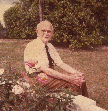 |
As John Guilding wrote soon after his release, “Well, to the trusting
Christian he finds that his God is the God all patience and can afford to
let patience have her perfect work; when it comes to a rush then he is able
to experience ‘the peace of God that passeth all understanding.’” |
| Dr. Arthur Barnett, speaking to a meeting of the Gospel Missionary Society
in New Britain, Connecticut six months after the sinking of the Zamzam,
remembered remembered a common sight in the sky that became a special sign to
him and others. “When the firing ceased after about ten minutes, and
we stepped out on the deck, that across the sky was the most beautiful rainbow
we had ever seen. In Genesis God told us, I do set my bow in the clouds
that the waters will no more become a flood to destroy all flesh.”
We praised God for this sign of His covenant. When we left [Brazil]
the last sight of the city was framed in a rainbow. When we up on board
the raider another bow shown across the sky. Every time we were in danger,
a bow appeared, once there was a double rainbow, and one night a moon-bow
appeared. Thank God for the rainbow! There is a rainbow every time there
is a storm; if you only look for it, it is there.” |
|
 |
Alice Schellenberg looked back on her whole life since the Zamzam
when she reflected some sixty years later:SHUSTER: “How
has your experiences on the Zamzam effected your life and faith,
since then?
|
 |
Here is another comment from a survivor, not an adult at the time like
Arthur and Alice but a babe in arms. Mary Fix Fawcett was seventeen months
old on April 17, 1941, too young, you might think, for to have any memories.
But as she described to me in a 2006 e-mail, she does.
I had always been a very fearful person, and in fact I felt at times really controlled by fear. My mind knew that it was senseless and not pleasing to God, but in spite of learning many Bible verses about God's protection and His care for us, and the needlessness of anxiety, I was still a very anxious person. It never appeared on the surface that much. I hid it pretty well but I knew it in my own heart. But one day after coming to Brazil, in prayer I said to the Lord, "Father, You know the root of this fear, and I ask you to please show me so that I may be free from it." Well, within minutes, I was able to "see" with the eyes of my heart an infant being held in the arms of an adult on a ship, and I "felt" in my own emotions, my own heart, the panic that this infant at that moment was experiencing. The child felt terror, and was overcome with the panic- inducing movements of the people around her. I once...all at once I knew that this child was I, and I was responding to what was going on around me at the shelling of the Zamzam. I knew that I was feeling real terror and I knew also that I could do nothing about it. I couldn't even feel safe in the arms of the adult, which I took to be my father) because he also was helpless in the situation. So, as the Lord showed me this. I talked to Him right there and I asked Him to comfort that child and take the fears away. I felt His comforting voice and Presence reminding me that He is the all powerful one and He was seeing it all and He was in control. I remember feeling as if a great weight had been lifted off of my heart and from that day on, I have had peace--- not that I have not had times of fear, but I could never say again that I was a fearful person--- it doesn’t define me. God is so faithful to His own, and understands the deepest needs of our hearts, even when we may not.” |
| As Mary Fawcett’s comments show, the Zamzam has not sunk
yet. It is no more past than any event, small or great, is past. |
|
According to Islamic tradition, “Stop, stop” or “Zam
zam” were the words that Hagar cried when the Angel Gabriel struck
the ground and brought forth water to save her and her son Ishmael, as
told in Genesis 21:8-19. She was afraid that the water overflow the trench
she had dug for it and would disappear in the sand. But the water from
God’s blessing never stopped flowing and continues to this day. |
|
| “Stop, stop” was undoubtedly the wish of the passengers and
crew of the Zamzam as German shells interrupted the journeys they
thought they would be making. But in the unexpected brief terror and long
tensions and anxieties that were their companions they continued to travel, those that sought God’s
mercy and blessings found they continued to flow, even though they were
often severe mercies. The events of our lives are the outward pushes and
pulls that shape who we really are. God uses them to give us the choice
to know him better. |
|
| For many, the Zamzam and all it represented was one of the most
important events of their lives and continued to be something they wanted
to remember and share. And their memories, preserved in the Archives among
other places, are part of our common experience, part of the cloud of witness
that surrounds us. They are where we start as we run our race, making our
unceasing lifelong pilgrimage to God and learning to trust in Him to guide
us and help us face all the unexpected turns our path will take, to experience
the grace through Christ Jesus which never stops. |